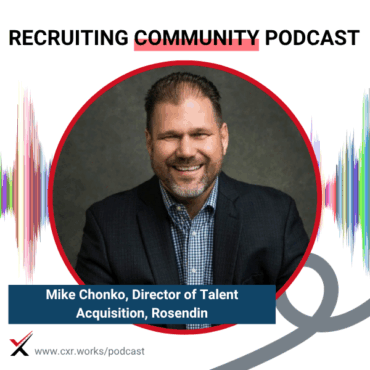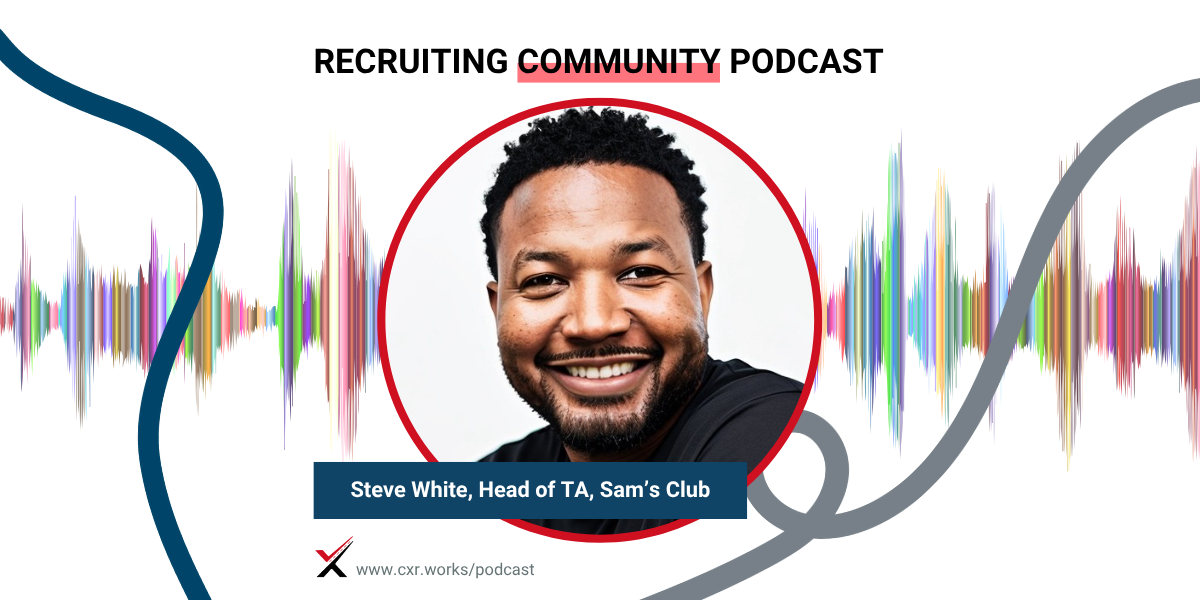
Hiring at Scale & Speed
What happens when AI meets high-volume skilled trades hiring? Rosendin’s Mike Chonko shares how TA strategy adapts under pressure—without losing the human touch.
 play_arrow
play_arrow
From Operations to Coaching: Lori Chartrand’s Career Crossroads Cami Grace
 play_arrow
play_arrow
Beyond ‘Don’t Do X’: Compliance as Problem-Solving Cami Grace
 play_arrow
play_arrow
Career Crossroads: A New Series from the CXR Team Cami Grace
 play_arrow
play_arrow
Agentic AI in Talent Acquisition: What Recruiters Need to Know and Plan For Cami Grace

Host: Chris Hoyt, President of CareerXroads
Guest: Steve White, Head of Talent Acquisition, Sam’s Club
🎙️ CXR Podcast: Embedded Impact & Talent Transformation with Steve White of Sam’s Club
In this episode, we sit down with Steve White, new Head of Talent Acquisition at Sam’s Club, for a thought-provoking conversation on embedding TA into the business, rethinking partnerships, and leading with intention.
Steve shares his leadership mindset and why curiosity is the key to becoming a true business partner. He opens up about aligning TA strategy with broader business goals, the power of micro value propositions (MVPs), and how he’s planning to transform both culture and candidate experience at Sam’s Club.
⏱ Episode Highlights
[2:35] – From transactional to transformational: How TA can align with business goals
[3:45] – Avoiding shiny tech traps: Using AI to amplify, not patch broken processes
[5:10] – The mindset shift: From “supporting” the business to partnering with it
[7:27] – Crafting your MVP: Micro value propositions that actually attract the right talent
[10:01] – Getting leaders visible: Why employer brand starts at the top
[12:52] – “TA catalyzes company growth” – How Steve defines impact
🔗 Links & Resources
Learn more about Sam’s Club: samsclub.com
Connect with the CXR recruiting community: cxr.works
⭐ Enjoyed the Episode?
If Steve’s bold perspective inspired you, we’d love for you to follow, rate, and review the show. Share this episode with a colleague who’s ready to move from supporting the business to helping lead it.
Title:
TA as a Business Partner with Steve White
Featured Guests:
Steve White, Head of Talent Acquisition, Sam’s Club
Hosts:
Chris Hoyt, President, CareerXroads
Episode Overview:
In this episode, Chris Hoyt sits down with Steve White, newly appointed Head of Talent Acquisition at Sam’s Club, to discuss his transition into the role and how he plans to align talent strategy with business goals. They explore the importance of curiosity, partnership over support, and embedding TA within business functions. Steve also shares his views on employer branding, the role of AI in recruiting, and the critical need for leaders to engage directly with talent.
Key Topics:
Aligning TA strategy with broader business objectives
The role of curiosity and relationship-building in TA leadership
Differentiating EVP (Employee Value Proposition) from MVP (Micro Value Proposition)
The cultural shift from “supporting” to “partnering” with business leaders
Critical thinking around AI adoption in recruiting
Importance of leader visibility in talent attraction
Excitement around Matchr’s candidate experience innovations
Notable Quotes:
“We need to make sure we’re not just adding AI to bad processes, bad culture, or bad ways of working.” — Steve White
“It’s about being curious about what’s going on in their world… No—you don’t just call me. I’m here. I’m part of your team.” — Steve White
“We need 100% focus on the EVP and 100% on the MVP.” — Steve White
“Culture matters. Leadership matters. And we have so much opportunity for transformation in TA.” — Steve White
Takeaways:
Steve White emphasizes that successful TA leadership begins with deep curiosity and alignment with the business’s strategic goals. He advocates for redefining TA’s role from a support function to a proactive partnership, highlighting the dual importance of EVP and MVP in attracting the right talent. With innovation and authenticity, TA leaders can transform both candidate experience and internal impact.
Want more conversations like this?
Subscribe to the CXR podcast and explore how top talent leaders are shaping the future of recruiting. Learn more about the CareerXroads community at cxr.works.
Announcer: Welcome to the Recruiting Community Podcast, the go-to channel for talent acquisition leaders and practitioners. This show is brought to you by CXR, a trusted community of thousands connecting the best minds in the industry to explore topics like attracting, engaging, and retaining top talent. Hosted by Chris Hoyt and Jerry Crispin.
We are thrilled to have you join the conversation.
Chris Hoyt: Welcome. This is the CXR Recruiting Community Podcast, where we bring together TA leaders to talk about what’s going on in their space—their head space—what excites them about the industry, and of course, the event, if they want to chat a little bit about that.
Today, Shaker Recruitment Marketing has been kind enough to sponsor a place for us to sit down and catch up, which is much more comfortable than standing around the stages and chatting. I’ve got with me today, Steve White. Steve, give us kind of an escalator pitch. Who’s Steve White? What are you doing now? Because you’ve had a big—
Steve White: —change. Yeah, I have had a big change. Most recently, I’ve shifted over to become the Head of Talent Acquisition for Sam’s Club. So I’m part of the Walmart enterprise, reporting up to Rob Dougherty, who’s a fantastic TA leader and VP of the enterprise over at Walmart.
Super excited about what’s ahead within the Walmart enterprise and what we’re able to do for Sam’s Club. It’s a phenomenal organization that I’m excited to be a part of and ready to drive some change for our TA organization and the org as a whole.
Chris Hoyt: And this is fresh—like a month in?
Steve White: Yeah, barely a month in. I was just telling Chris I barely know how to spell Sam’s Club. I probably shouldn’t say that too often anymore.
Chris Hoyt: Well, I think they give you another 30 days. At least. Then you’re off—no more shiny penny. You’ve gotta dive in.
Steve White: You’re right. This is it. I’m seasoned as a guest at this point.
Chris Hoyt: Exactly. So, we’ve got a couple questions we put together that we think are kind of interesting, but we do tend to veer off a little. Attention deficit… “Hey, look, a squirrel.”
Steve White: That’s the best way to do it.
Chris Hoyt: If we do it, we do it. It’ll be fine. I want to dive into something interesting because we were just talking yesterday about what’s going on on the floor, the topics of discussion, and what you’re seeing when you’re talking to other leaders.
Is there a piece of advice, based on what you’ve seen so far and the discussions you’ve had, that you would give to another TA leader as they come up on the middle of the year and start planning for 2026 already?
Steve White: A couple of things come to mind. First, how embedded are we in the business? How focused are we on the business’s goals—not just understanding what they are, but truly aligning our TA goals and strategy with the business strategy?
Eventually, we should be able to set our own OKRs based on those business goals. I’d like to see that shift happen in our space—being ingrained and aligned with what’s happening in the business.
Second, there’s a lot of talk about AI. It’s critical. There’s a lot of change happening, and it’s necessary. But we need to make sure we’re not just adding AI to bad processes, bad culture, or bad ways of working. We should ensure that the AI we’re implementing is not just additive but exponential. It should fundamentally change our organizations.
Chris Hoyt: So what I hear a little bit is—it’s not about adding technology or solutions for the sake of it. It’s about aligning them with the business needs, not just the TA needs. Broader business needs.
Steve White: Exactly. How are we adding solutions that drive the business forward—not just fix a problem in TA, but really help the end users, our customers, our shareholders, from a bottom-line perspective?
Chris Hoyt: I’ve known you for a number of years—really gotten to know you well the last two or three—and I just adore the work you do and the mindset you bring. Let me ask you this: Based on your experience, how do you become ingrained in the business that way? It’s easy to say we’re going to implement new tech or update processes. But how do you form those partnerships? How do you become that true business partner so many of us strive to be?
Steve White: I think it starts with curiosity. What questions are we asking? How curious are we about the business, about the leaders we’re partnering with?
And I say “partnering with”—not “supporting”—because I hate the word “supporting” in this context. It makes us small. Especially in front of high-ranking leaders.
It’s about being curious about what’s going on in their world. Building those relationships. Asking to attend their staff meetings. Creating a business plan around what’s happening in their function. Letting them know upfront that TA isn’t going to lead the conversation—their business strategy is going to lead, and talent will follow in alignment.
Some leaders are taken aback by that, others get excited. But we need to push past the “I’ll call you when I need you” mindset. No—you don’t just call me. I’m here. I’m part of your team. That’s where the magic happens.
Chris Hoyt: I love the callout of “support” versus “partnership.” And I love that you’re saying it’s about leading with inquiry when approaching any line of business.
Steve White: 100 percent.
Chris Hoyt: Okay. Talent attraction strategy. Now, I know you’re new at Sam’s. Still shiny penny. You’re in evaluation mode. Once you figure out how to spell Sam’s, the next step is digging in. But how will you assess what the talent attraction strategy is? How do you determine what to pivot—or double down on?
Steve White: Two things. First, the EVP—what’s our employee value proposition? How do we shape and communicate our employer brand to attract the right people who will move the business strategy forward?
Second, the MVP—the micro value proposition. That’s about each role, each function, each leader. It’s specific. And it’s critical. You can’t overlook it.
Chris Hoyt: You don’t hear a lot of people talk about MVP.
Steve White: We have to. It’s like the old “glocal” idea—80% global, 20% local. But I’d say it’s 100/100. We need 100% focus on the EVP and 100% on the MVP. Because that MVP really matters to the individual candidates—the people joining that specific team under that specific leader.
Chris Hoyt: So the EVP becomes almost a touchstone. This is the North Star. And the MVP is the customization and delivery at the local level.
Steve White: Absolutely. And we’ve got to get more leaders out in front of talent. On LinkedIn, wherever. They need to share: Who are you? What’s it like to work for you? What does this role mean to the business?
We’ve talked about it for years, but we have to make it happen—leaders engaging directly with talent.
Chris Hoyt: I can’t wait to circle back with you in about 90 days and see how this mindful approach is playing out. I know Rob’s one of the best partners you could ask for.
Steve White: Totally. I’m super excited to learn from Rob and partner with him on this.
Chris Hoyt: So, we’re asking everyone this: If you were going to write a book—and I’ve told you, I think you’ve got a book in you—what would the title be?
Steve White: Last time we talked, it was “Relationships, Results, Readiness.” I think I’d shift that now—something related to culture. Or maybe “Think and Act.”
How are we thinking? How are we engaging? The curiosity, the partnership, the way we show up. Not making ourselves small in front of leadership. Culture matters. Leadership matters. And we have so much opportunity for transformation in TA.
So maybe “Think and Act” needs work—but it’s a working title.
Chris Hoyt: Working title. I love it. So who gets the first signed copy?
Steve White: Always—Taj, my wife. She’s the smartest person in our family, phenomenal, and has been incredibly supportive. She picked up and moved to Bentonville with me. It has to be her.
Chris Hoyt: You’re a smart man. If you need help with the forward, I’m in.
Steve White: I’ll need help with everything—title, forward, all of it.
Chris Hoyt: Love it. Well, we’ve got a panel later. I’m excited for that. Anything you’ve seen on the floor that’s been exciting?
Steve White: Matchr is the most exciting thing I’ve seen. Candidate experience is critical, and what they’re doing—showing candidates how they match to a job—is revolutionary. That impacts both internal mobility and external hiring in a big way.
Chris Hoyt: And you’ve got that mad scientist Doug Berg and that operational genius Elaine Orler running it. It’s gonna be fun to watch.
Steve White: Amazing team.
Chris Hoyt: Thanks for sitting down with us.
Steve White: Thank you, Chris. Always an honor.
Chris Hoyt: Past and future episodes, you can catch us at cxr.org/podcast. We try to do this weekly, but when we’re on the road, we jam a bunch in. Thanks again to Shaker for giving us a spot to sit down and catch up. Thanks, everybody.
Announcer: Thanks for listening to the Recruiting Community Podcast, where talent acquisition leaders connect, learn, and grow together. Be sure to visit cxr.works/podcast to explore past episodes, see what’s coming up next, and find out how you can join the conversation. Whether you’ve got insights to share or want to be a guest on the show, we’d love to hear from you. If you’re interested in learning more about becoming a member of the CXR community, visit us at www.cxr.works. We’ll catch you in the next episode.
Tagged as: Walmart, EVP, employee engagement, Talent Acquisition, Podcast.
Chris Hoyt is the President of CareerXroads, a global peer community for talent acquisition leaders driving strategic change. With decades of experience leading recruiting innovation at Fortune 500 companies, Chris now advises enterprise TA teams on tech, process, and leadership. He’s a frequent speaker at conferences like SHRM, HR Tech, LinkedIn, and UNLEASH, and he’s known for pushing conversations beyond buzzwords to get to what really works in hiring. Through CXR, he connects top TA professionals to solve real problems, challenge norms, and shape the future of recruiting.

What happens when AI meets high-volume skilled trades hiring? Rosendin’s Mike Chonko shares how TA strategy adapts under pressure—without losing the human touch.